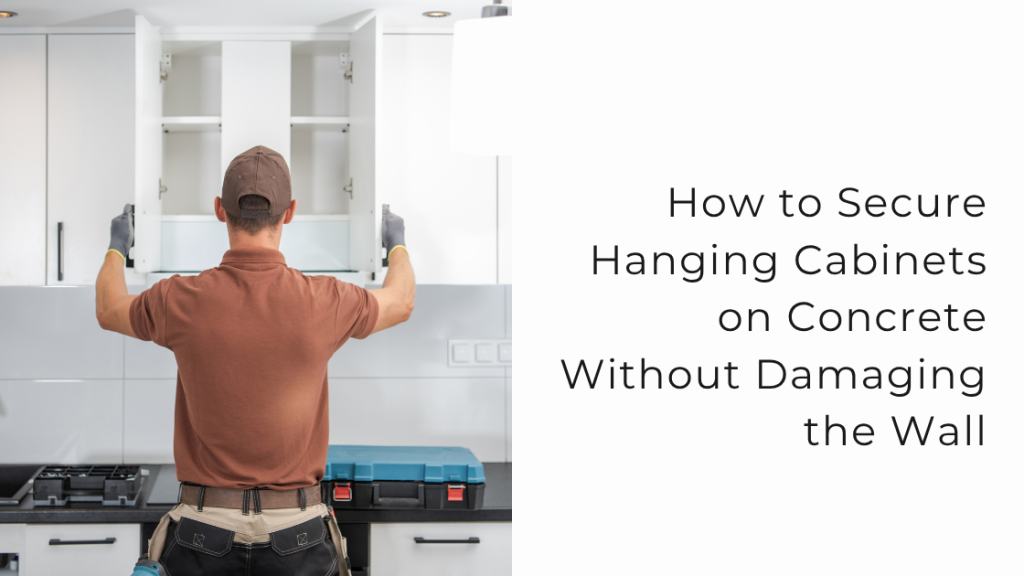If you’ve ever tried drilling into a concrete wall, you already know it’s not as easy as hanging something on drywall or wood. When it comes to installing cabinets, the challenge gets even trickier. Concrete is strong, yes, but that also means it’s tough to penetrate without the right tools or methods. Whether you’re setting up cabinets in your garage, laundry room, or kitchen, knowing how to install hanging cabinet on concrete wall properly makes all the difference.
Before you pick up that drill, it’s worth thinking about the best way to do it safely and securely; without cracking the wall or damaging your new cabinets. If you’d rather not deal with the stress or risk of doing it wrong, you can always count on professional help. A trusted Wall Hanging Installation service can take care of everything, from measuring to mounting, ensuring your cabinets stay firmly in place without causing any wall damage.
Why Installing on Concrete Is Different
Mounting cabinets on a concrete wall isn’t like working with drywall or studs. Concrete doesn’t “give” the same way wood does, so screws and nails won’t just go in easily. You’ll need special tools and hardware designed for masonry surfaces.
People often think they can just use regular screws, but that’s a big mistake. Regular screws won’t grip properly in concrete, which can cause your cabinet to loosen or fall over time. The key to learning how to install hanging cabinet on concrete wall is understanding how to create a strong anchor point without cracking or chipping the surface.
Start by Gathering the Right Tools and Materials
You don’t need a full workshop, but having the right tools will make your life a lot easier. You’ll need:
A hammer drill (a regular drill won’t be powerful enough)
Masonry drill bits sized for your anchors or screws
Concrete anchors or wall plugs
Lag screws or bolts for heavy cabinets
A level, measuring tape, and pencil for marking
Safety goggles and dust mask
These tools are essential if you want to install the cabinets safely without damaging the wall. The hammer drill is especially important; it’s built to handle concrete and gives you clean, deep holes without creating cracks around them.
Find the Right Spot for Your Cabinets
Before you start drilling, think about placement. Once you make holes in concrete, they’re pretty much permanent. Use your measuring tape to mark exactly where the cabinet will go. Always double-check the height and spacing.
If you’re hanging upper kitchen cabinets, the standard height is around 18 inches above the countertop, but you can adjust it based on your ceiling height or cabinet size. Use a level to ensure everything lines up perfectly.
When learning how to install hanging cabinet on concrete wall, marking accurately is half the job. Once the holes are drilled, there’s no easy way to “move it over an inch.”
Drill Carefully and Gradually
When you start drilling into the concrete, don’t rush. Begin with a smaller masonry bit to create a pilot hole, then switch to a larger bit that matches the size of your anchors. Use steady pressure, and let the hammer drill do the work.
Drilling too fast can overheat the bit or cause the concrete to chip. Keep the drill straight, and back it out occasionally to remove dust. Wearing goggles is a must; concrete dust can irritate your eyes quickly.
If you hit rebar (metal reinforcement inside the wall), stop drilling immediately. Rebar can damage your bit, and it’s usually better to move your hole slightly to avoid it.
Insert Anchors and Mount the Cabinet
Once your holes are drilled, clean out any dust before inserting the anchors. You can use a vacuum or blow the dust out gently. Then tap the anchors into the holes with a hammer until they sit flush with the wall.
If you’re using lag bolts, line up the cabinet’s mounting rail with the anchors and drive the bolts in using a wrench or drill. Don’t overtighten; just make sure it’s snug enough to hold weight without cracking the anchor.
For extra-heavy cabinets, it’s smart to use multiple anchors and bolts spaced evenly across the width. This spreads the weight and prevents the cabinet from pulling on one side.
Protecting the Wall from Damage
A lot of people worry about damaging concrete walls while installing cabinets, and it’s a valid concern. One simple way to prevent cracks is to use rubber washers between the cabinet and the wall. They cushion the surface and reduce pressure points when tightening bolts.
Another tip is to drill slowly and use a sharp masonry bit. Dull bits can cause vibrations that lead to small fractures around the holes.
If you’re nervous about drilling into concrete or want to avoid mistakes altogether, professional Wall Hanging Installation experts can handle this step for you. They use the right tools and techniques to make sure your cabinets are safely mounted without harming your walls.
Testing the Strength and Balance
After installation, it’s important to test your cabinets before loading them up. Give the cabinet a light shake to see if it moves or feels loose. If it’s solid and level, you’ve done it right.
Next, place a few items inside gradually. Start with lighter things like dishes or towels before adding heavier items. Watch for any shifting or signs that the anchors might be slipping.
If you notice movement or cracks forming around the bolts, stop using the cabinet and recheck the anchors. Sometimes, you may need longer screws or stronger wall plugs depending on the wall’s density.
Tips for a Cleaner Finish
Once your cabinet is secure, take a moment to tidy up. Use wall filler or paint to touch up any visible drill marks around the edges. You can also apply a bead of clear silicone between the cabinet and wall to seal out dust and moisture, especially in humid areas like bathrooms or kitchens.
Cable covers or trim can also make the setup look more professional. Small finishing touches make a big difference in giving your cabinets a polished, built-in look.
When to Call in Professionals
Installing cabinets on concrete might sound simple, but it’s not a one-size-fits-all job. The density of concrete can vary, and mistakes are expensive to fix. A small crack can spread, leading to bigger repairs later.
If you don’t have the right tools or just want to make sure it’s done perfectly, consider calling experienced installers. A reliable Wall Hanging Installation team will know how to assess your wall, pick the right anchors, and mount your cabinets cleanly and securely.
They’ll also take care of alignment and weight distribution, so you can skip the stress and focus on enjoying your upgraded space.
Final Thoughts
Learning how to install hanging cabinet on concrete wall takes a little patience, the right tools, and careful planning. The goal is to create a setup that’s both secure and clean without damaging your wall in the process.
Concrete might be tough, but with the right anchors, bolts, and drilling techniques, you can hang even the heaviest cabinets safely. Just remember; measure twice, drill once, and don’t rush the process. And if you’d rather not handle power tools yourself, you’re not alone. Professionals who handle Wall Hanging Installation daily can make it look effortless and guarantee that everything is secure, straight, and built to last.



